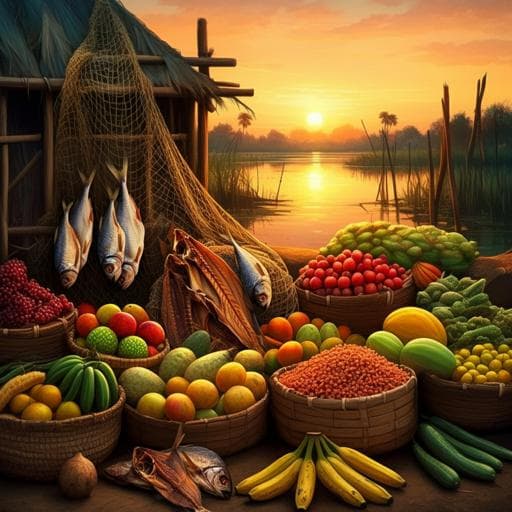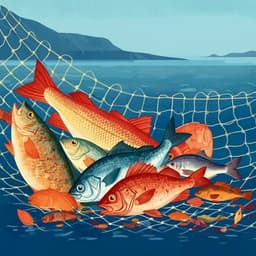
Economics
Proximity to small-scale inland and coastal fisheries is associated with improved income and food security
F. A. Simmance, G. Nico, et al.
Explore the vital link between small-scale fisheries and poverty alleviation in sub-Saharan Africa. This research by Fiona A. Simmance and colleagues reveals how engaging with fisheries can significantly improve food security and reduce income poverty, highlighting the importance of conserving these resources for sustainable development.
~3 min • Beginner • English
Introduction
The study addresses how small-scale fisheries influence household income poverty and food security in sub-Saharan Africa. Against a backdrop of high poverty and undernourishment in the region, and exacerbating pressures from COVID-19 and climate change, the authors highlight that small-scale fisheries provide critical livelihoods and nutrient-dense foods yet remain undervalued in policy discourse. Key knowledge gaps persist on who benefits from these fisheries and how proximity to fishing grounds and engagement in fisheries affect physical and economic access to food at nationally representative scales. The paper aims to quantify associations between proximity to fishing grounds, participation in small-scale fisheries, and household poverty and food security in Malawi, Tanzania, and Uganda.
Literature Review
Prior work shows small-scale fisheries support livelihoods, reduce poverty, and improve diet diversity, especially through nutrient-dense fish, including dried small species. Despite this, fisheries are often underrepresented in food systems policymaking and data systems. Studies in the African Great Lakes and Western Indian Ocean regions indicate significant contributions of small-scale fisheries to local diets and economies, but evidence at national scales and clarity on distribution of benefits remain limited. Export-oriented value chains (e.g., Nile Perch on Lake Victoria) can reduce local retention of benefits. The paper builds on this literature by leveraging nationally representative data and a fisheries module to examine spatial and livelihood determinants of poverty and food security.
Methodology
Study design: A food systems framing was used to examine two pathways: physical access to food via proximity to small-scale fisheries (fish as food) and economic access via livelihoods in small-scale fisheries (fish as income). Country selection: Malawi (2016–17 LSMS-ISA), Tanzania (2014–15), and Uganda (2010–11) were selected due to the importance of inland and coastal small-scale fisheries. Data: 18,715 georeferenced household observations from LSMS-ISA with a dedicated fisheries module (fish consumption frequency/quantity/form; fisheries livelihoods across harvesting, processing, trading). Households were surveyed over 12 months to capture seasonality. Geospatial matching: Household GPS coordinates were matched to inland water bodies (GLWD; permanent open waters ≥0.1 km², including cross-border) and coastlines (ESA GlobCover). Distance to fishing grounds was computed as straight-line distance (km) from household to nearest water body or coastline. Descriptive threshold: For descriptive statistics, households proximate were defined as ≤5 km and distant as >5 km from fishing grounds, guided by prior studies and distance quintiles. Livelihood classification: Households were categorized as (i) fishing (any member in harvesting, processing, trading; in Uganda, fishing only), (ii) agriculture (crop/livestock; no fish-related activities), or (iii) neither. Note: 96% of fishing households also did agriculture. Outcomes: Poverty measured as per-capita monthly expenditure below national poverty line; asset wealth index via PCA combining durable goods and access to infrastructure; food security via Food Consumption Score (FCS) and subjective seasonal food insecurity (months without enough food). Fish consumption quantified as kg/household/week (wet weight), frequency (days/7), form (fresh, dried, smoked, other), and source (purchased/own/gift). Prices: Constructed from value and volume of purchased foods; converted to international USD via PPP and adjusted to real 2010 prices via CPI to compare across countries/years. Nutrition: Drew on food composition databases and FishBase/IHH to contextualize nutrient density (e.g., calcium, iron, omega-3), especially for small dried fish. Econometric analysis: Two probit models estimated marginal effects for (1) probability of being income poor and (2) probability of being food insecure (poor FCS). Key regressors included continuous distance to water bodies (km), distance to food markets (km), an interaction of distance to water bodies among households unable to reach food markets, and livelihood category (neither; fishing; agriculture), with a specification restricting livelihood categories to households proximate to water bodies. Controls: age and sex of household head, education level, household size, ratio employed, and wealth index. Models estimated at cross-country (pooled), national, and rural levels with survey weights and country/district fixed effects. Limitations in measurement: Straight-line distances may differ from travel time; however, literature indicates high correlation (R>0.91). Household GPS coordinates were randomly offset (0–2 km urban; 0–5 km rural) to protect confidentiality; authors argue classification into proximate vs distant remains robust as offsets apply across groups.
Key Findings
- Engagement and proximity: 3.4% of households engaged in small-scale fisheries across the value chain. Proximity to water bodies increased likelihood of fisheries engagement and was associated with improved outcomes.
- Poverty associations: Each 1 km increase in distance to fishing grounds from the mean (33.1 km) increased the probability of being income poor by 0.14 percentage points (β=0.00136, p<0.01). Households proximate to water bodies (avg 2.7 km) had an estimated 15.2 percentage points lower probability of income poverty than those distant (avg 79.3 km), controlling for covariates. Fishing households were 9 percentage points less likely to be poor than agriculture households, but had a higher probability (~16 percentage points) of being poor than households that neither fish nor farm. Country heterogeneity: In rural Uganda, fishing households were more likely to be income poor than both non-fishing/non-farming households (+9.2 pp) and agriculture households (+3.3 pp); in rural Malawi, fishing households were less likely to be income poor than both agriculture (-9.3 pp) and neither households. Households near fishing grounds and engaged in fisheries had higher primary education and asset wealth but faced marginalization in market access and land.
- Food security associations: Each 1 km increase in distance to fishing grounds increased probability of food insecurity (poor FCS) by 0.03 percentage points (β=0.00032, p<0.01). Proximate households had 12.6 percentage points lower probability of food insecurity than distant households. Small-scale fisheries livelihoods were associated with lower food insecurity compared to agriculture households and to neither fishing nor agriculture households (approximately -9.8 and -5 percentage points, respectively). By country, associations did not hold in Uganda, where fishing households were more food insecure than agriculture households. Fisheries households experienced 0.26 fewer months of seasonal food insecurity than non-fishing households.
- Diet patterns: Fish was the dominant animal-source food consumed across urban and rural areas (33–73% of households consumed fish; higher than eggs/beef <40% and poultry/goat/pork <20%). Malawi and Tanzania had the highest fish consumption shares (73% and 71%). In Uganda, fish and beef consumption were similar (~33% vs 32%). Food secure households consumed fish about three times more than food-insecure households. Over 95% of fish was purchased, especially among households distant from water bodies (97%), though subsistence consumption was notable among fishing households near fishing grounds (Malawi 41%; Tanzania 18%; Uganda 36%).
- Form, quantity, frequency: Proximity and fisheries engagement were associated with roughly double the quantities and frequencies of fish consumption. Wealthier households consumed about twice as much fish as poorer households, but proximity to fishing grounds reduced inequality in fish consumption quantities by ~30% on average. Uganda showed weaker or no association. Dried fish dominated in Malawi (71%) and Uganda (64%); fresh fish dominated in Tanzania (71%). Urban households consumed more fresh fish (1.3×), while rural households consumed more dried fish (1.2×). Households distant from fishing grounds (>5 km) were 1.5× more likely to consume dried fish than proximate households.
- Affordability and nutrition: Fish, particularly dried small fish eaten whole, was both more affordable (lower price/kg) and more nutrient-dense (e.g., calcium, iron, omega-3) than other animal-source foods, especially near small-scale fisheries.
- Scale: The sample represents more than 19 million households and a population of 93.8 million across the three countries.
Discussion
Findings indicate that proximity to fishing grounds and participation in small-scale fisheries are positively associated with reduced income poverty and improved food security, supporting SDGs 1 (no poverty) and 2 (zero hunger). Benefits are strongest in rural areas where fishing grounds are located and where formal markets are weaker, suggesting small-scale fisheries can mitigate limited market access. Fish is the most frequently consumed animal-source food and is key for diet quality; dried small fish are especially important for remote rural populations, indicating trade and distribution networks extend benefits beyond fishing communities. Proximity reduces inequalities in fish consumption between wealth quintiles, contributing to SDG 10 (reduced inequalities). Heterogeneity across countries reflects differences in value chains and definitions: Uganda’s export-oriented Nile Perch fishery appears to limit local retention of benefits, and the survey’s definition there included only harvesting. The results underscore that while fisheries households may have better education and assets, they face marginalization in market and land access. Policy implications include strengthening governance to prioritize local benefits, improving post-harvest handling and trade (especially dried small fish) to reach distant vulnerable populations, and integrating fisheries into food systems policies and data. Leveraging small pelagic species and reducing losses could expand access; a modeled 1% increase in fish supply could allow ~250,000 additional people to meet a 28 g/day fish intake across the three countries.
Conclusion
Small-scale fisheries significantly contribute to reducing poverty and improving food security in Malawi, Tanzania, and Uganda by enhancing both physical and economic access to fish. Proximity to fishing grounds and engagement in fisheries livelihoods are associated with lower income poverty and better food consumption profiles. Dried small fish play a crucial, affordable, and nutrient-dense role, particularly for rural and remote households. Recognizing and integrating the value of small-scale fisheries in policies and governance can accelerate progress towards SDGs 1, 2, 10, and 14b. The study demonstrates the utility of augmenting national household surveys with fisheries modules to generate policy-relevant insights. Future work should focus on equitable value-chain governance, improved post-harvest practices and distribution (especially of dried small fish), and targeting strategies to ensure benefits reach distant and vulnerable populations.
Limitations
- Causality: Analyses are correlational; probit models estimate associations, not causal effects.
- Distance measurement: Straight-line distance to water bodies may not reflect true travel time or access; however, it is highly correlated with network-based measures in other studies.
- GPS displacement: Household coordinates were randomly offset (up to 2 km urban; 5 km rural) for privacy, potentially introducing spatial noise, though classification into proximate vs distant is expected to remain unbiased.
- Cross-country definitions: Fishing household definitions differ (Uganda includes only harvesting; Malawi and Tanzania include harvesting, processing, trading), affecting comparability.
- Unobserved factors: The study did not model other socio-economic drivers (e.g., agency, mobility, land tenure, infrastructure) that may influence poverty and food security near fishing grounds.
- Temporal differences: Country survey years differ (2010–11 to 2016–17); price data were PPP and CPI adjusted, but temporal heterogeneity remains.
- Lack of species detail: Surveys lacked fish species information, limiting species-specific nutritional inference.
Related Publications
Explore these studies to deepen your understanding of the subject.







